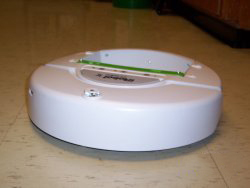 an unmodified iRobot Create with Command Module (small green attachment). | |
| Manufacturer | iRobot |
|---|---|
| Type | robot |
| Release date | 2007 |
| Website | edu |
iRobot Create is a hobbyist robot manufactured by iRobot that was introduced in 2007 and based on their Roomba vacuum cleaning platform. The iRobot Create is explicitly designed for robotics development and improves the experience beyond simply hacking the Roomba. [1] [2] The Create replaces its Roomba predecessor's vacuum cleaner hardware with a cargo bay that also houses a DB-9 port providing serial communication, digital input & output, analog input & output, and an electric power supply. [1] [2] [3] The Create also has a 7-pin Mini-DIN serial port through which sensor data can be read and motor commands can be issued using the iRobot Roomba Open Interface (ROI) protocol. [4]
Contents
The platform accepts virtually all accessories designed for iRobot's second generation Roomba 400 Series domestic robots and can also be programmed with the addition of iRobot's own Command Module (a microcontroller with a USB connector and four DE-9 expansion ports). [4] As of 2013 [update] , the Command Module is no longer being sold. [5] In 2014, iRobot replaced the original model with the Create 2, [6] which is constructed from the chassis of remanufactured 600-series Roombas; instead of replacing the old command module, iRobot encourages the use of commodity single-board micro-controllers like Arduino and single-board computers like Raspberry Pi to provide additional processing power.


